
Uncertainty Chapter 13
Uncertainty Chapter 13
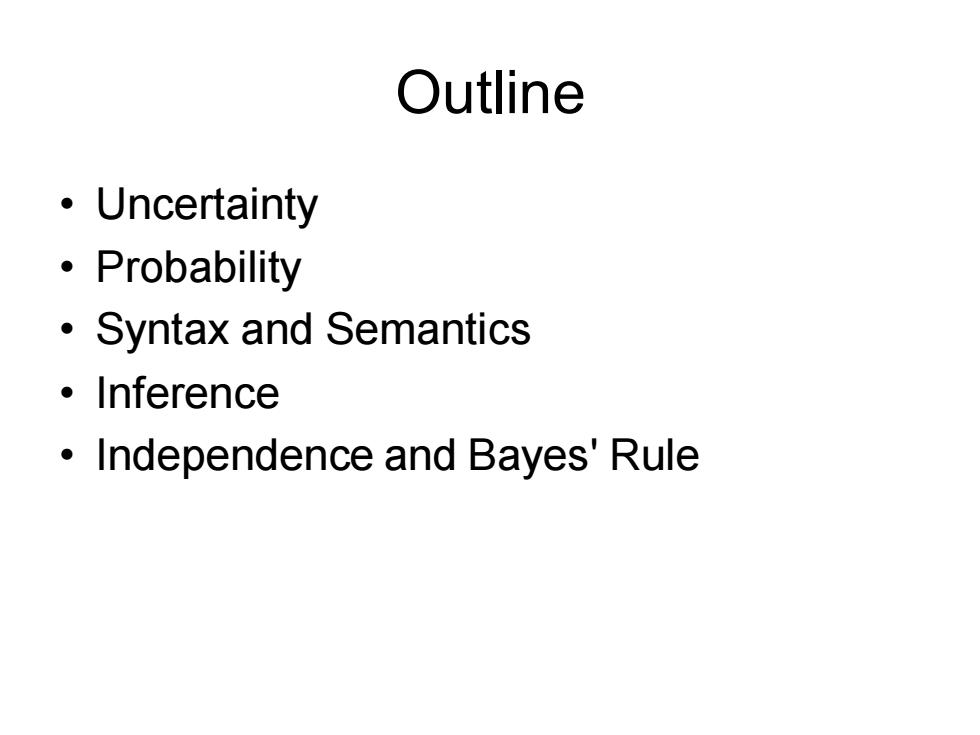
Outline 。Uncertainty ·Probability ·Syntax and Semantics ·Inference Independence and Bayes'Rule
Outline • Uncertainty • Probability • Syntax and Semantics • Inference • Independence and Bayes' Rule
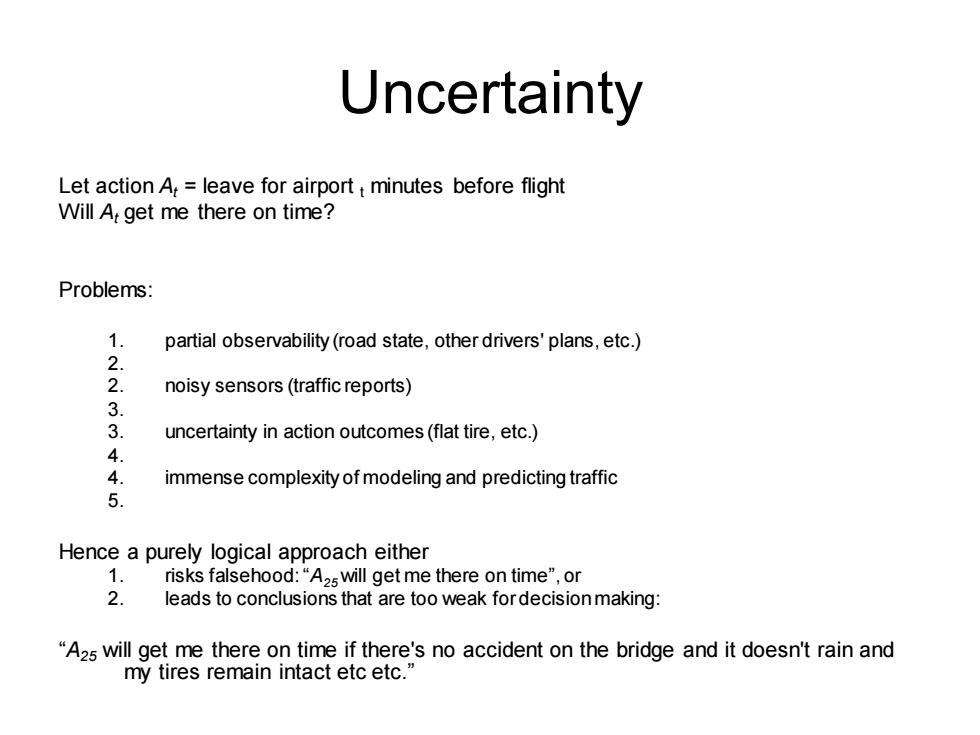
Uncertainty Let action At leave for airportt minutes before flight Will A:get me there on time? Problems: 1. partial observability(road state,other drivers'plans,etc.) 2. 2. noisy sensors (traffic reports) 3. uncertainty in action outcomes(flat tire,etc.) 4. 4. immense complexity of modeling and predicting traffic Hence a purely logical approach either 1. risks falsehood:"A2swill get me there on time",or 2.leads to conclusions that are too weak fordecision making: "A2s will get me there on time if there's no accident on the bridge and it doesn't rain and my tires remain intact etc etc
Uncertainty Let action At = leave for airport t minutes before flight Will At get me there on time? Problems: 1. partial observability (road state, other drivers' plans, etc.) 2. 2. noisy sensors (traffic reports) 3. 3. uncertainty in action outcomes (flat tire, etc.) 4. 4. immense complexity of modeling and predicting traffic 5. Hence a purely logical approach either 1. risks falsehood: “A25 will get me there on time”, or 2. leads to conclusions that are too weak for decision making: “A25 will get me there on time if there's no accident on the bridge and it doesn't rain and my tires remain intact etc etc.” (A might reasonably be said to get me there on time but I'd have to stay overnight in
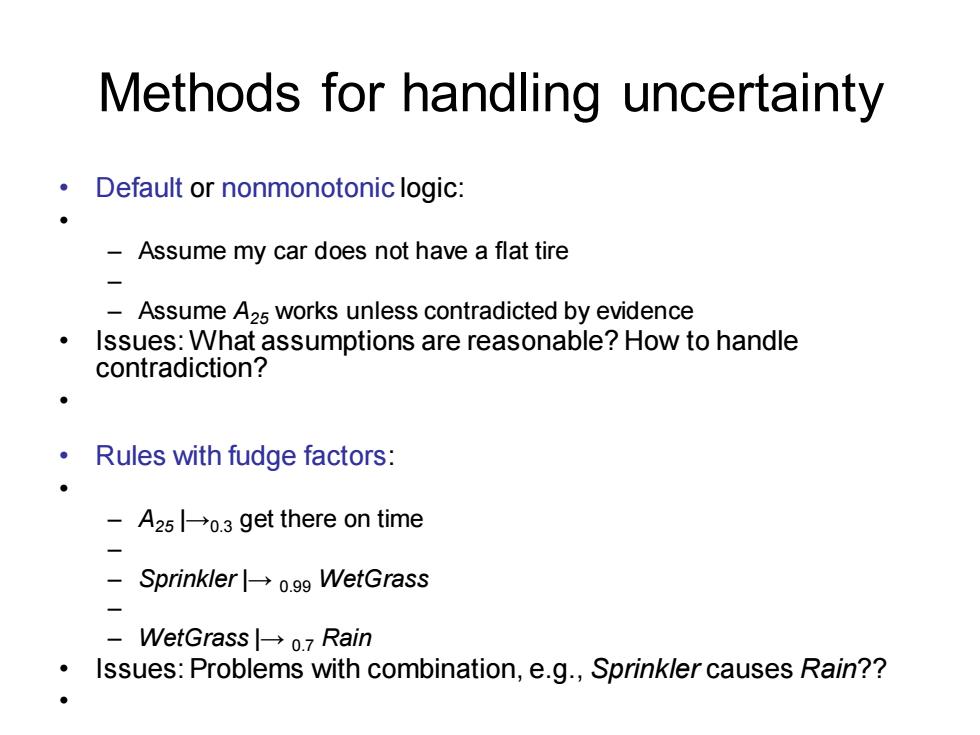
Methods for handling uncertainty Default or nonmonotonic logic: Assume my car does not have a flat tire Assume A25 works unless contradicted by evidence Issues:What assumptions are reasonable?How to handle contradiction? ● Rules with fudge factors: ● -A251-0.3 get there on time Sprinkler0.99 WetGrass -VetGrass→o.7Rain Issues:Problems with combination,e.g.,Sprinkler causes Rain??
Methods for handling uncertainty • Default or nonmonotonic logic: • – Assume my car does not have a flat tire – – Assume A25 works unless contradicted by evidence • Issues: What assumptions are reasonable? How to handle contradiction? • • Rules with fudge factors: • – A25 |→0.3 get there on time – – Sprinkler |→ 0.99 WetGrass – – WetGrass |→ 0.7 Rain • Issues: Problems with combination, e.g., Sprinkler causes Rain?? •
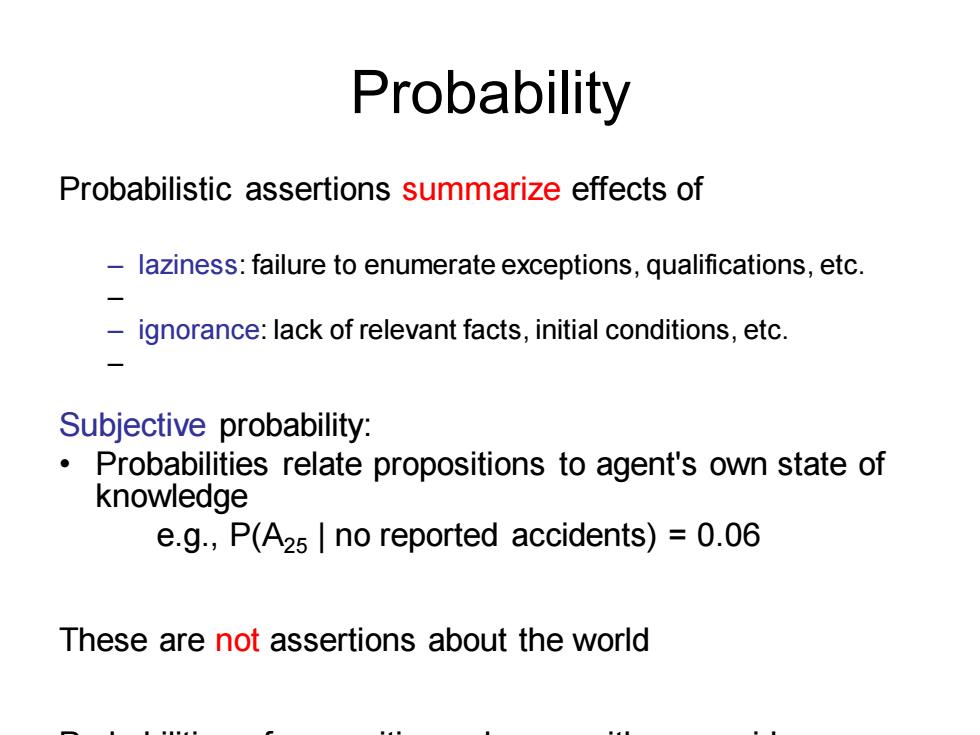
Probability Probabilistic assertions summarize effects of laziness:failure to enumerate exceptions,qualifications,etc. 一 ignorance:lack of relevant facts,initial conditions,etc. Subjective probability: Probabilities relate propositions to agent's own state of knowledge e.g.,P(A25 I no reported accidents)=0.06 These are not assertions about the world
Probability Probabilistic assertions summarize effects of – laziness: failure to enumerate exceptions, qualifications, etc. – – ignorance: lack of relevant facts, initial conditions, etc. – Subjective probability: • Probabilities relate propositions to agent's own state of knowledge e.g., P(A25 | no reported accidents) = 0.06 These are not assertions about the world Probabilities of propositions change with new evidence:
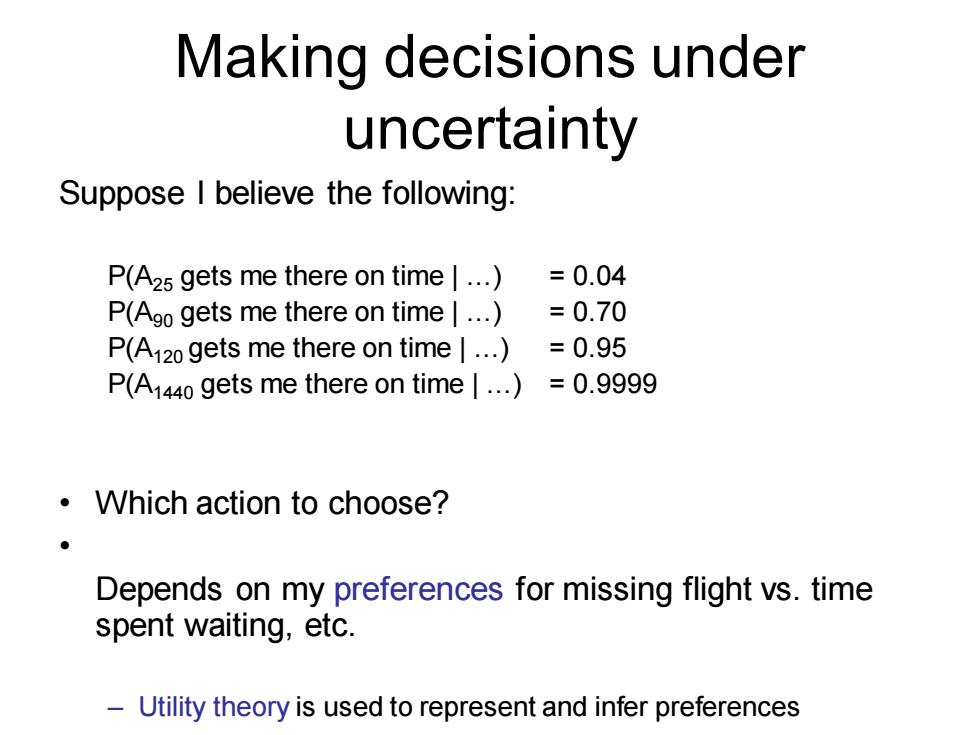
Making decisions under uncertainty Suppose I believe the following: P(A25 gets me there on time 1...) =0.04 P(Ago gets me there on time l...) =0.70 P(A120 gets me there on time |... =0.95 P(A1440 gets me there on time |... =0.9999 Which action to choose? Depends on my preferences for missing flight vs.time spent waiting,etc. Utility theory is used to represent and infer preferences
Making decisions under uncertainty Suppose I believe the following: P(A25 gets me there on time | …) = 0.04 P(A90 gets me there on time | …) = 0.70 P(A120 gets me there on time | …) = 0.95 P(A1440 gets me there on time | …) = 0.9999 • Which action to choose? • Depends on my preferences for missing flight vs. time spent waiting, etc. – Utility theory is used to represent and infer preferences –
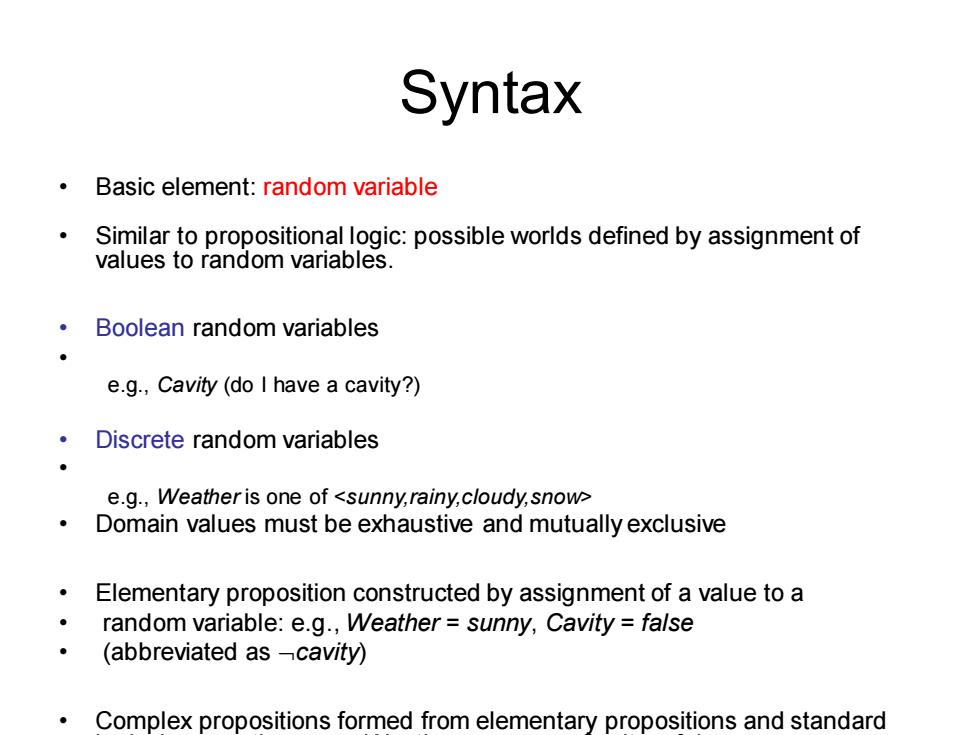
Syntax Basic element:random variable Similar to propositional logic:possible worlds defined by assignment of values to random variables. Boolean random variables e.g.,Cavity(do I have a cavity?) Discrete random variables e.g.,Weather is one of <sunny,rainy,cloudy,snow Domain values must be exhaustive and mutually exclusive Elementary proposition constructed by assignment of a value to a random variable:e.g.,Weather sunny,Cavity false (abbreviated as -cavity) Complex propositions formed from elementary propositions and standard
Syntax • Basic element: random variable • Similar to propositional logic: possible worlds defined by assignment of values to random variables. • Boolean random variables • e.g., Cavity (do I have a cavity?) • Discrete random variables • e.g., Weather is one of • Domain values must be exhaustive and mutually exclusive • Elementary proposition constructed by assignment of a value to a • random variable: e.g., Weather = sunny, Cavity = false • (abbreviated as cavity) • Complex propositions formed from elementary propositions and standard logical connectives e.g., Weather = sunny Cavity = false

Syntax Atomic event:A complete specification of the state of the world about which the agent is uncertain ● E.g.,if the world consists of only two Boolean variables Cavity and Toothache,then there are 4 distinct atomic events: Cavity false ^Toothache=false Cavity false Toothache true Cavity true Toothache false Cavity true Toothache true Atomic events are mutually exclusive and
Syntax • Atomic event: A complete specification of the state of the world about which the agent is uncertain • E.g., if the world consists of only two Boolean variables Cavity and Toothache, then there are 4 distinct atomic events: Cavity = false Toothache = false Cavity = false Toothache = true Cavity = true Toothache = false Cavity = true Toothache = true • Atomic events are mutually exclusive and exhaustive
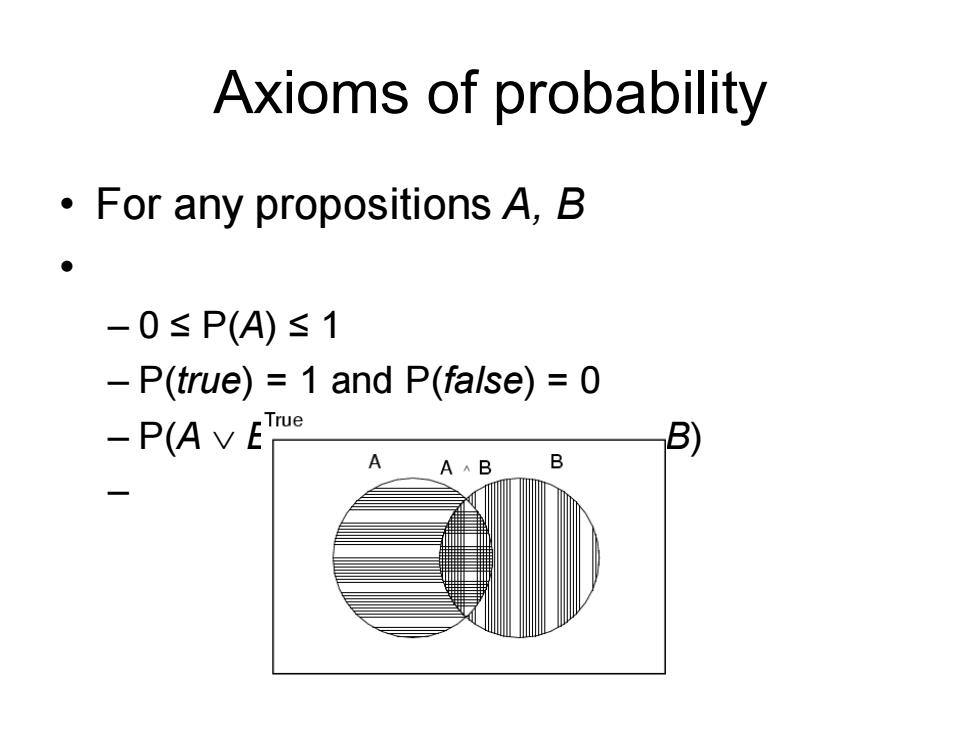
Axioms of probability For any propositions A,B ● -0≤P(A)≤1 -P(true)=1 and P(false)=0 -P(AVETUe B) B
Axioms of probability • For any propositions A, B • – 0 ≤ P(A) ≤ 1 – P(true) = 1 and P(false) = 0 – P(A B) = P(A) + P(B) - P(A B) –

Prior probability Prior or unconditional probabilities of propositions e.g.,P(Cavity true)=0.1 and P(Weather=sunny)=0.72 correspond to belief prior to arrival of any(new)evidence Probability distribution gives values for all possible assignments: P(Weather)=(normalized,i.e.,sums to 1) Joint probability distribution for a set of random variables gives the probability of every atomic event on those random variables P(Weather,Cavity)=a 4X 2 matrix of values: Weather= sunny rainy cloudy snow Cavity true 0.144 0.02 0.016 0.02 Cavity false 0.576 0.08 0.0640.08
Prior probability • Prior or unconditional probabilities of propositions • e.g., P(Cavity = true) = 0.1 and P(Weather = sunny) = 0.72 correspond to belief prior to arrival of any (new) evidence • Probability distribution gives values for all possible assignments: • P(Weather) = (normalized, i.e., sums to 1) • Joint probability distribution for a set of random variables gives the probability of every atomic event on those random variables • P(Weather,Cavity) = a 4 × 2 matrix of values: Weather = sunny rainy cloudy snow Cavity = true 0.144 0.02 0.016 0.02 Cavity = false 0.576 0.08 0.064 0.08 • Every question about a domain can be answered by the joint distribution